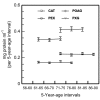Age-related aqueous humor (AH) and lens epithelial cell/capsule protein carbonylation and AH protein concentration in cataract patients who have pseudoexfoliative diseases
- PMID: 30713426
- PMCID: PMC6334981
Age-related aqueous humor (AH) and lens epithelial cell/capsule protein carbonylation and AH protein concentration in cataract patients who have pseudoexfoliative diseases
Abstract
Purpose: The aim of this study is to investigate the age-correlation of oxidative stress (OS, assessed by the accumulative OS damage marker protein carbonyls) in aqueous humour (AH; together with protein concentration) and lens epithelial cells plus capsule (LECs/capsule) in patients with cataract (CAT), and also suffering from pseudoexfoliation syndrome (PEX), primary open-angle glaucoma (POAG) and pseudoexfoliation glaucoma (PXG).
Methods: AH samples from 78 male/female patients (21, 20, 19 and 18 with CAT, PEX, PXG, and POAG, respectively), and LECs/capsule samples from 104 male/female patients (34, 32, 18, and 20 with CAT, PEX, PXG and POAG, respectively) were collected during phacoemulsification CAT surgery. Average protein carbonyl concentrations were measured in patients grouped in 5-year age intervals (ranging from 56-60 to 86-90). The non-overlapping age ranges and numbers of the tested subjects did not allow comparative follow up studies for the tested diseases.
Results: There is an age-dependent increase of protein carbonyls in AH (nmol mg-1 protein and ml-1), and in the order CAT<PXG=~POAG<PEX and CAT<PEX=~POAG<PXG respectively. Moreover, protein concentration in AH accumulates in the order CAT<PEX<POAG<PXG but is not age-related. An age-dependent increase of protein carbonyls (nmol mg-1 protein) is also observed in LECs/capsule, and in the order CAT<PEX=~POAG<PXG.
Conclusions: The present study shows for the first time an age-increased OS-induced protein damage (protein carbonyl formation) in the AH and LECs/capsule of CAT patients with PEX, POAG or PXG. The slow rate of change of protein carbonyls strongly suggests a long-term implication of OS in ocular disease pathogenesis. Additionally, protein concentration levels in the AH of CAT patients increase independently of age, and in same as with protein carbonyls increasing order levels for CAT<POAG<PXG in AH and LECs/capsule. This may suggest a protein cross-diffusion taking place between AH and LECs/capsule, most likely originating from PEX deposition and/or necrotic/apoptotic LECs/capsule. Moreover, the findings of the present study establish the use of protein carbonyls (together with a methodology for their more accurate quantification, which overcomes serious unreliability problems of past methods) as an age accumulative marker of OS damage, for future studies that investigate long-term OS involvement in pseudoexfoliative ocular disorders.
Figures



Similar articles
-
Novel protein constituents of pathological ocular pseudoexfoliation syndrome deposits identified with mass spectrometry.Mol Vis. 2018 Dec 28;24:801-817. eCollection 2018. Mol Vis. 2018. PMID: 30713420 Free PMC article.
-
Quantification of blood--aqueous barrier breakdown after trabeculectomy: pseudoexfoliation versus primary open-angle glaucoma.J Glaucoma. 1999 Feb;8(1):18-23. J Glaucoma. 1999. PMID: 10084270
-
Proteomic characteristics of the aqueous humor in Uyghur patients with pseudoexfoliation syndrome and pseudoexfoliative glaucoma.Exp Eye Res. 2024 Jun;243:109903. doi: 10.1016/j.exer.2024.109903. Epub 2024 Apr 18. Exp Eye Res. 2024. PMID: 38642601
-
Proteomics of pseudoexfoliation materials in the anterior eye segment.Adv Protein Chem Struct Biol. 2021;127:271-290. doi: 10.1016/bs.apcsb.2021.03.004. Epub 2021 Apr 26. Adv Protein Chem Struct Biol. 2021. PMID: 34340770 Review.
-
The aqueous humor proteome of primary open angle glaucoma: An extensive review.Exp Eye Res. 2020 Aug;197:108077. doi: 10.1016/j.exer.2020.108077. Epub 2020 May 27. Exp Eye Res. 2020. PMID: 32470343 Review.
Cited by
-
Metabolomics Reveals Differences in Aqueous Humor Composition in Patients With and Without Pseudoexfoliation Syndrome.Front Mol Biosci. 2021 May 14;8:682600. doi: 10.3389/fmolb.2021.682600. eCollection 2021. Front Mol Biosci. 2021. PMID: 34055894 Free PMC article.
-
Protective effect of apelin-13 in lens epithelial cells via inhibiting oxidative stress-induced apoptosis.BMC Ophthalmol. 2024 Nov 4;24(1):479. doi: 10.1186/s12886-024-03746-6. BMC Ophthalmol. 2024. PMID: 39497115 Free PMC article.
-
Oxidative Stress in Cataract Formation: Is There a Treatment Approach on the Horizon?Antioxidants (Basel). 2024 Oct 16;13(10):1249. doi: 10.3390/antiox13101249. Antioxidants (Basel). 2024. PMID: 39456502 Free PMC article. Review.
-
Emerging roles of oxidative stress in the pathogenesis of pseudoexfoliation syndrome (Review).Exp Ther Med. 2022 Jul 28;24(3):602. doi: 10.3892/etm.2022.11539. eCollection 2022 Sep. Exp Ther Med. 2022. PMID: 35949329 Free PMC article. Review.
References
-
- Zhou L, Li Y, Yue BY. Oxidative stress affects cytoskeletal structure and cell-matrix interactions in cells from an ocular tissue: the trabecular meshwork. J Cell Physiol. 1999;180:182–9. - PubMed
-
- Izzotti A, Saccà SC, Cartiglia C, De Flora S. Oxidative deoxyribonucleic acid damage in the eyes of glaucoma patients. Am J Med Sci. 2003;114:638–46. - PubMed
-
- Truscott RJ, Augusteyn RC. Oxidative changes in human lens proteins during senile nuclear cataract formation. Biochim Biophys Acta. 1977;492:43–52. - PubMed
-
- Varma SD, Chand D, Sharma YR, Kuck JF, Jr, Richards RD. Oxidative stress on lens and cataract formation: role of light and oxygen. Curr Eye Res. 1984;3:35–57. - PubMed
Publication types
MeSH terms
Substances
LinkOut - more resources
Full Text Sources
Medical
Miscellaneous

